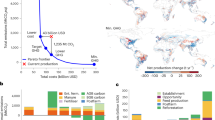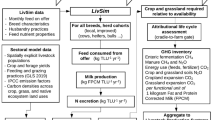Abstract
Recent debate about agricultural greenhouse gas emissions mitigation highlights trade-offs inherent in the way we produce and consume food, with increasing scrutiny on emissions-intensive livestock products1,2,3. Although most research has focused on mitigation through improved productivity4,5, systemic interactions resulting from reduced beef production at the regional level are still unexplored. A detailed optimization model of beef production encompassing pasture degradation and recovery processes, animal and deforestation emissions, soil organic carbon (SOC) dynamics and upstream life-cycle inventory was developed and parameterized for the Brazilian Cerrado. Economic return was maximized considering two alternative scenarios: decoupled livestock–deforestation (DLD), assuming baseline deforestation rates controlled by effective policy; and coupled livestock–deforestation (CLD), where shifting beef demand alters deforestation rates. In DLD, reduced consumption actually leads to less productive beef systems, associated with higher emissions intensities and total emissions, whereas increased production leads to more efficient systems with boosted SOC stocks, reducing both per kilogram and total emissions. Under CLD, increased production leads to 60% higher emissions than in DLD. The results indicate the extent to which deforestation control contributes to sustainable intensification in Cerrado beef systems, and how alternative life-cycle analytical approaches result in significantly different emission estimates.
This is a preview of subscription content, access via your institution
Access options
Subscribe to this journal
Receive 12 print issues and online access
$209.00 per year
only $17.42 per issue
Buy this article
- Purchase on Springer Link
- Instant access to full article PDF
Prices may be subject to local taxes which are calculated during checkout




Similar content being viewed by others
References
Bajželj, B. et al. Importance of food-demand management for climate mitigation. Nature Clim. Change 4, 924–929 (2014).
Tilman, D., Balzer, C., Hill, J. & Befort, B. L. Global food demand and the sustainable intensification of agriculture. Proc. Natl Acad. Sci. USA 108, 20260–20264 (2011).
Garnett, T. et al. Agriculture. Sustainable intensification in agriculture: premises and policies. Science 341, 33–34 (2013).
Herrero, M. et al. Smart investments in sustainable food production: revisiting mixed crop-livestock systems. Science 327, 822–825 (2010).
Steinfeld, H. et al. Livestock’s Long Shadow Vol. 3 (Organization, 2006).
Herrero, M., Thornton, P. K., Gerber, P. & Reid, R. S. Livestock, livelihoods and the environment: understanding the trade-offs. Curr. Opin. Environ. Sustain. 1, 111–120 (2009).
Smith, P. Delivering food security without increasing pressure on land. Glob. Food Secur. 2, 18–23 (2013).
Godfray, H. C. J. et al. Food security: the challenge of feeding 9 billion people. Science 327, 812–818 (2010).
Soussana, J. F., Tallec, T. & Blanfort, V. Mitigating the greenhouse gas balance of ruminant production systems through carbon sequestration in grasslands. Animal 4, 334–350 (2010).
FAOStat (FAO, accessed 15 January 2015); http://faostat3.fao.org/browse/Q/QL/E.
Brazilian Institute of Geography and Statistics Censo Agropecuário 2006 (2006 Agricultural Census) (Instituto Brasileiro de Geografia e Estatítisca (IBGE), accessed 5 June 2015); http://www.sidra.ibge.gov.br/bda/acervo/acervo2.asp.
Brazilian agriculture: the miracle of the Cerrado. The Economist (26 August 2010); http://www.economist.com/node/16886442.
Rohter, L. Scientists are making Brazil’s savannah bloom. The New York Times (2 October 2007); http://www.nytimes.com/2007/10/02/science/02tropic.html?pagewanted=all&_r=0.
Maia, S. M. F., Ogle, S. M., Cerri, C. E. P. & Cerri, C. C. Effect of grassland management on soil carbon sequestration in Rondônia and Mato Grosso states, Brazil. Geoderma 149, 84–91 (2009).
Braz, S. P. et al. Soil carbon stocks under productive and degraded pastures in the Brazilian Cerrado. Soil Sci. Soc. Am. J. 77, 914–928 (2013).
Eggleston, S., Buendia, L., Miwa, K., Ngara, T. & Tanabe, K. 2006 IPCC Guidelines for National Greenhouse Gas Inventories Vol. 4 (IPCC, 2006); http://www.ipcc-nggip.iges.or.jp/public/2006gl/vol4.html.
De Gouvello, C. et al. Brazil Low-Carbon Country Case Study (World Bank Group, 2010); http://siteresources.worldbank.org/BRAZILEXTN/Resources/Brazil_LowcarbonStudy.pdf.
Smith, P. Do grasslands act as a perpetual sink for carbon? Glob. Change Biol. 20, 2708–2711 (2014).
Johnston, A. E., Poulton, P. R. & Coleman, K. Soil organic matter: its importance in sustainable agriculture and carbon dioxide fluxes. Adv. Agron. 101, 1–57 (2009).
Cerri, C. E. P. et al. Simulating SOC changes in 11 land use change chronosequences from the Brazilian Amazon with RothC and Century models. Agric. Ecosyst. Environ. 122, 46–57 (2007).
Lapola, D. M. et al. Pervasive transition of the Brazilian land-use system. Nature Clim. Change 4, 27–35 (2014).
Nepstad, D. et al. Slowing Amazon deforestation through public policy and interventions in beef and soy supply chains. Science 344, 1118–1123 (2014).
Macedo, M. N. et al. Decoupling of deforestation and soy production in the southern Amazon during the late 2000s. Proc. Natl Acad. Sci. USA 109, 1341–1346 (2012).
Strassburg, B. B. N. et al. When enough should be enough: improving the use of current agricultural lands could meet production demands and spare natural habitats in Brazil. Glob. Environ. Change 28, 84–97 (2014).
Mozzer, G. B. in Climate Change in Brazil: Economic, Social and Regulatory Aspects (ed. Seroa da Motta, R.) Ch. 6 (IPEA, 2011); https://www.ipea.gov.br/agencia/images/stories/PDFs/livros/livros/livro_climatechange_ingles.pdf#page=108.
Hedenus, F., Wirsenius, S. & Johansson, D. A. The importance of reduced meat and dairy consumption for meeting stringent climate change targets. Climatic Change 124, 1–13 (2014).
Rada, N. Assessing Brazil’s Cerrado agricultural miracle. Food Policy 38, 146–155 (2013).
Bustamante, M. M. C. et al. Estimating greenhouse gas emissions from cattle raising in Brazil. Climatic Change 115, 559–577 (2012).
Parton, W. J., Schimel, D. S., Cole, C. V. & Ojima, D. S. Analysis of factors controlling soil organic matter levels in Great Plains grasslands. Soil Sci. Soc. Am. J. 51, 1173–1179 (1987).
Acknowledgements
We acknowledge financial support from the EU FP7 project AnimalChange under the grant agreement no. 266018. R.d.O.S. acknowledges the CAPES Foundation for the scholarship no. 10180/13-3. D.M. acknowledges financial support from the Scottish Government Rural and Environmental Science and Analytical Services division through ClimatexChange (http://www.climatexchange.org.uk).
Author information
Authors and Affiliations
Contributions
R.d.O.S., L.G.B. and D.M. designed the study and wrote the paper, R.d.O.S. and L.G.B. developed the mathematical model, R.d.O.S. implemented the model and generated the results, J.A.J.H. contributed to the model development and mathematical solutions, M.F.M. provided the LCA data, T.Z.A. provided the bioeconomic data, and F.A.F. performed the simulations with the CENTURY model.
Corresponding author
Ethics declarations
Competing interests
The authors declare no competing financial interests.
Supplementary information
Supplementary Information
Supplementary Information (PDF 1650 kb)
Supplementary Information
Supplementary Information (XLS 61 kb)
Rights and permissions
About this article
Cite this article
de Oliveira Silva, R., Barioni, L., Hall, J. et al. Increasing beef production could lower greenhouse gas emissions in Brazil if decoupled from deforestation. Nature Clim Change 6, 493–497 (2016). https://doi.org/10.1038/nclimate2916
Received:
Accepted:
Published:
Issue Date:
DOI: https://doi.org/10.1038/nclimate2916
This article is cited by
-
Sparing or expanding? The effects of agricultural yields on farm expansion and deforestation in the tropics
Biodiversity and Conservation (2023)
-
Fuzzy logic indicators for the assessment of farming sustainability strategies in a tropical agricultural frontier
Agronomy for Sustainable Development (2023)
-
Economic and environmental impacts of integrated systems adoption in Brazilian agriculture-forest frontier
Agroforestry Systems (2023)
-
Can global models provide insights into regional mitigation strategies? A diagnostic model comparison study of bioenergy in Brazil
Climatic Change (2022)
-
Environmental Impacts of Large-Scale Spirulina (Arthrospira platensis) Production in Hellisheidi Geothermal Park Iceland: Life Cycle Assessment
Marine Biotechnology (2022)



